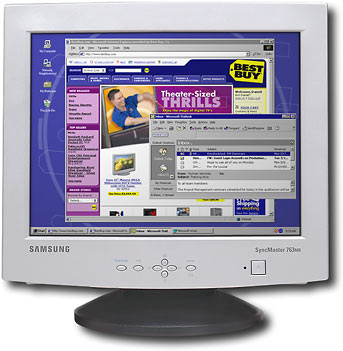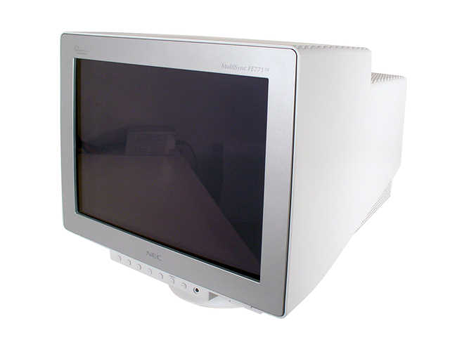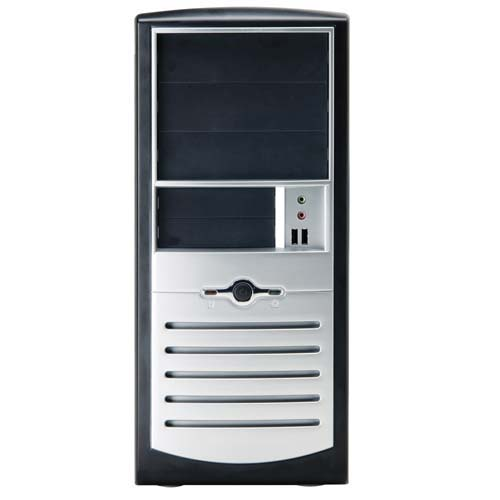Weekly Buyer's Guide: Entry Level Guide - April 2004
by Evan Lieb on April 17, 2004 3:05 PM EST- Posted in
- Guides
Monitor
Recommendation: Samsung SyncMaster 17" Flat-Tube (model 763MB)Price: $150 shipped

Samsung's SyncMaster series of monitors are very popular for price-conscious buyers. With a 0.20mm dot pitch, 1280x1024 max resolution, and 3-year manufacturer warranty, you're getting a good bang-for-your-buck monitor. You can pick this monitor up at your local Best Buy if you don't feel like waiting several days for your monitor to arrive in the mail. We suggest calibrating your monitor for maximum clarity if you do a lot of desktop work. Consult your manual or an online guide on how to calibrate a monitor.
Monitor Alternative: NEC Diamondtron 17" CRT (model FE771SB)
Price: $161 shipped

In just 4 weeks, the NEC FE771SB has dropped about $14 in price from $175 to $161. A welcome change if there ever was one for CRTs, a particularly slow moving market these days. Anyway, this NEC model is one of the lower end models of the famous Diamondtron series of monitors. Max resolution is just 1280x1024 and dot pitch is a mediocre 0.25mm. However, the clarity and viewable area (16") of this monitor are better than the Samsung SyncMaster 763MB, and at just about $11 more, it is a nice little upgrade if you're willing to spend the extra dollars.
Computer Case
Recommendation: CaseEdge TS1 Mid TowerPrice: $40 shipped

You can purchase this case online at www.pcclub.com or go to a local PC Club to pick it up. Not only is the black and silver edition of this case very good looking, but the setup is very easy to use and convenient in general. For one, the motherboard mounting screws come installed in their proper holes, a welcome change from having to screw them in by hand. Secondly, the hard drive and optical drive bays contain plastic clips that allow you to install your drives simply and easily without screws. All in all, this case basically comes completely "preinstalled", and even includes a 300W PSU (power supply unit). Any AMD or Intel approved power supply will do for a budget system, considering how little power a system like this draws, but if you're feeling extra cautious for future upgrades, picking up a Sparkle 300W PSU is a fine choice. The price of a Sparkle 300W PSU is about $21 shipped online.
Alternative: Foxconn Super Case 100-G2-P4 Mid Tower
Price: $44 shipped

While this case isn't quite as easy to use or as aesthetically appealing as the CaseEdge TS1, it is still a fine computer case with all the space that you'll need for your budget system. It comes with an AMD approved 300W PSU, but as we said before, you can always opt for a better 300W power supply if you feel like you need an especially good PSU for future upgrades. Still, a free PSU is usually never a bad thing.
In the end, as long as you purchase a case that accepts an ATX motherboard, the choice of computer case is completely up to you, the consumer. There are many aesthetically appealing computer cases out there - don't let our preferences stop you from exploring other computer cases online or at a local retail outlet like PC Club, Best Buy, CompUSA, etc.
If you cannot find the lowest prices on the products that we've recommended on this page, it's because we don't list some of them in our RealTime pricing engine. Until we do, we suggest that you do an independent search online at the various vendors' web sites. Just pick and choose where you want to buy your products by looking for a vendor located under the "Vendor" heading.










22 Comments
View All Comments
TrogdorJW - Monday, April 26, 2004 - link
Here's something that was missed, I think. When talking about the RAM, they mention the CAS 3.0 vs. CAS 2.5 or whatever. However, they're using a 133 MHz bus (PC2100 RAM).Now, correct me if I'm wrong, but if you have PC3200 RAM with 3-3-3-8 timings, it should run perfectly well at PC2100 speed with 2-2-2-6 or possibly even 2-2-2-5 timings. Why? Well, 3200 is 52.4% more than 2100, and 3 is only 50% more than 2. Right?
Anyway, back in the good old SDRAM days, I remember picking up some CAS3 "PC150" RAM and running it at CAS2 since I had a 100 MHz bus speed at the time. Funny thing was that PC150 was cheaper than PC100 with CAS2. Seems like that's happening in the DDR market now.
newuser12 - Sunday, April 18, 2004 - link
seems like the 512 mg of ram is a pretty universal idea....And I agree with whoever is saying that celerons suck ass. "value" and "celeron"? LOL!
Etacovda - Sunday, April 18, 2004 - link
Not a bad choice - ive made similar systems in the past. For a value system, why not get a 40gig WD SE drive... without filling the system up with wares, im sure that would be enough for most uses ;) i doubt they will be buying 10 new games to put on it as that comes to about the same price as the system.Great choice on the mobo, there is only 2 gripes i have with that board - the caps are very close to the socket for aftermarket cooler installs, and for some reason the one i had hated mbm5.
512 of ram is a good idea - theres a 'value' system, then there is just building the cheapest system you can build... there is a difference :p
boomerang - Sunday, April 18, 2004 - link
While I have admired the styling and pricing of the manufacturers of the cases you are recommending for some time, I would never purchase one. The reason being because of the severe air flow restrictions imposed on the rear case fans.I can't imagine how any air could even begin to go through those little tiny holes.
With quiet systems becoming very much desirable these days, I would like to see some cases that could meet those expectations in your guides.
The quietest fan becomes noisy when the air has no place to go.
ZobarStyl - Sunday, April 18, 2004 - link
If you are building a value-level rig and a customer "has to have Intel" then you have one seriously dumb customer. I mean, fanboys and the perennial fight aside, the value market has always belonged to AMD and a Celeron is a horrible processor to sell anyone when a comparable speed Athlon XP is actually cheaper. And don't say the PR ratings are off when the XP's have more L1 cache than all of the Celeron's L1 and L2 combined...read any review on any decent tech website and you will never see a Celeron in any section but the "stay away from these processors" part. Point is I could never sell a Celeron-based system to a customer I would feel like I was cheating him.Booty - Sunday, April 18, 2004 - link
#10 - Celerons are awful CPUs. I wouldn't put one in a system if *Intel* payed *me*... well, maybe then, but anyway... ;)512 MB ram should be the minimum put into ANY system these days, period. I don't agree about using a mATX nForce board, just because they haven't seemed very stable to me - maybe I just haven't found the right memory to use with one, but it's not like I used cheap memory. I think in most cases that onboard video causes more problems than it's worth - if they had dedicated video memory built onto the mobo, that'd be one thing, but I'd rather not have it using up system memory.
I'd also agree that going with one of the Antec cases (SLK1600 or 3700) or something similar would definately be worth it. You're better spending a little more and having a system that's stable and problem-free than going too cheap and running into problems. But hey, the "techs" out there building these cheap systems are keeping me in business, since I'm always having to replace cheap parts with quality ones when they die a year later.
artifex - Sunday, April 18, 2004 - link
Are SFF designs getting close enough in price for consideration in your monthly budget/mid-range system reviews?thebluesgnr - Saturday, April 17, 2004 - link
I would replace the motherboard with the MSI K7N2 Delta-L or ABIT NF7 2.0. They cost the same as the ASUS and have better quality (nForce2 Ultra 400 and better power solutions). Specially the ABIT has better quality.Dual channel doesn't make much difference but it's likely this system will be upgraded in the future with another stick of RAM so getting the nForce2 Ultra 400 for no extra money at all is a no-brainer imho.
You may also consider a SiS 748 based board. You can get the ASRock K7S8XE for only $51 shipped (newegg.com) or the Gigabyte for only $54. But the ASRock is on-pair with the "-X" series boards from ASUS as far as components quality goes.
yanon - Saturday, April 17, 2004 - link
BTW, most mini-ATX NForce2 400 IGP board do come with a AGP port. So, the user always have the option to a better graphic card.yanon - Saturday, April 17, 2004 - link
To be a true entry-level machine, it should have an integrated motherboard. Any one of those mini-ATX NForce2 400 IGP board with GF4MX video and Cmedia 6 channel sound should be fine. Granted that this type of motherboard will only have a 3 pci slots, but an entry level does not need all those expension slots because people who will buy this type of machine just want to surf the web, listen to mp3, some word processing, basic digital photo editing, and occassional gaming (mostly online java-based games). My cousin can play MOHAA on such a machine. 512 Mbytes of ram is a must and NEC 2500A 8X DVD+/-RW drive should also be part of this system since DVD burning is rising in popularity as the cost for a 50-pack Ritek 4.7G DVD-R is only $40 on Newegg now. Entry-level computer builder should consider using the $50 silver Enermax (including a 350watt powersupply) since it has that expensive aluminum look and 2 frontal USB jacks plus audio/mic jacks. Another advantage of using this case is that it has lots holes in the lower portion of the front panel. Moving the back fan to the front will provide ample cooling to all the components inside. All buyer should consider spend extra $20 to buy a retail cpu instead of an OEM cpu since retail comes with a heatsink-and-fan and 1 year warranty. Buying a cheap heatsink and fan unit for the oem CPU will cost you at least $10 more and without an 1 year warranty for the CPU.